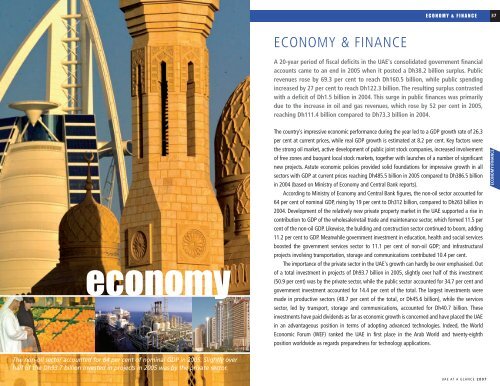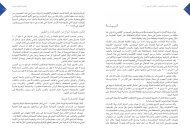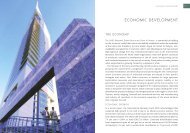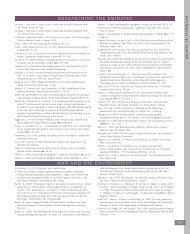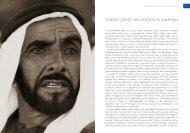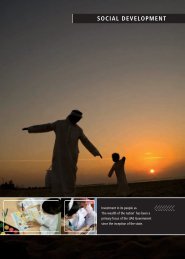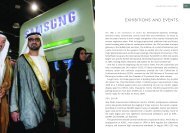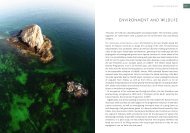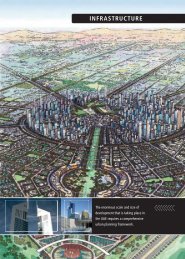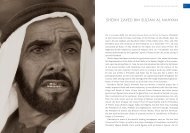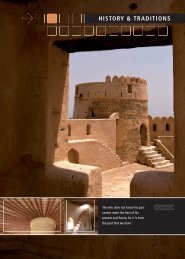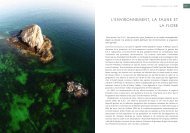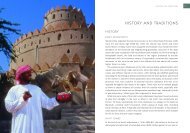You also want an ePaper? Increase the reach of your titles
YUMPU automatically turns print PDFs into web optimized ePapers that Google loves.
ECONOMY & FINANCE37ECONOMY & FINANCEA 20-year period of fiscal deficits in the <strong>UAE</strong>'s consolidated government financialaccounts came to an end in 2005 when it posted a Dh38.2 billion surplus. Publicrevenues rose by 69.3 per cent to reach Dh160.5 billion, while public spendingincreased by 27 per cent to reach Dh122.3 billion. The resulting surplus contrastedwith a deficit of Dh1.5 billion in 2004. This surge in public finances was primarilydue to the increase in oil and gas revenues, which rose by 52 per cent in 2005,reaching Dh111.4 billion compared to Dh73.3 billion in 2004.<strong>economy</strong>The country's impressive economic performance during the year led to a GDP growth rate of 26.3per cent at current prices, while real GDP growth is estimated at 8.2 per cent. Key factors werethe strong oil market, active development of public joint stock companies, increased involvementof free zones and buoyant local stock markets, together with launches of a number of significantnew projects. Astute economic policies provided solid foundations for impressive growth in allsectors with GDP at current prices reaching Dh485.5 billion in 2005 compared to Dh386.5 billionin 2004 (based on Ministry of Economy and Central Bank reports).According to Ministry of Economy and Central Bank figures, the non-oil sector accounted for64 per cent of nominal GDP, rising by 19 per cent to Dh312 billion, compared to Dh263 billion in2004. Development of the relatively new private property market in the <strong>UAE</strong> supported a rise incontribution to GDP of the wholesale/retail trade and maintenance sector, which formed 11.5 percent of the non-oil GDP. Likewise, the building and construction sector continued to boom, adding11.2 per cent to GDP. Meanwhile government investment in education, health and social servicesboosted the government services sector to 11.1 per cent of non-oil GDP; and infrastructuralprojects involving transportation, storage and communications contributed 10.4 per cent.The importance of the private sector in the <strong>UAE</strong>'s growth can hardly be over emphasised. Outof a total investment in projects of Dh93.7 billion in 2005, slightly over half of this investment(50.9 per cent) was by the private sector, while the public sector accounted for 34.7 per cent andgovernment investment accounted for 14.4 per cent of the total. The largest investments weremade in productive sectors (48.7 per cent of the total, or Dh45.6 billion), while the servicessector, led by transport, storage and communications, accounted for Dh40.7 billion. Theseinvestments have paid dividends as far as economic growth is concerned and have placed the <strong>UAE</strong>in an advantageous position in terms of adopting advanced technologies. Indeed, the WorldEconomic Forum (WEF) ranked the <strong>UAE</strong> in first place in the Arab World and twenty-eighthposition worldwide as regards preparedness for technology applications.ECONOMY/FINANCEThe non-oil sector accounted for 64 per cent of nominal GDP in 2005. Slightly overhalf of the Dh93.7 billion invested in projects in 2005 was by the private sector.<strong>UAE</strong> AT A GLANCE 2007
<strong>UAE</strong> AT A GLANCE 2007ECONOMY/FINANCE38@ www.uaeinteract.com/<strong>economy</strong>Balance of trade figures (FOB) achieved a surplus in 2005 amounting to Dh163 billion againstDh101 billion in 2004. Total exports and re-exports rose by 26.9 per cent to reach Dh424 billionin 2005, while imports rose to Dh261 billion in 2005 from Dh233 billion in 2004. As a result of theincrease in oil prices and the increase in production of condensates, the value of oil exports roseby 46.8 per cent in 2005, reaching Dh159.8 billion. The weighted average of oil prices rose fromUS$36.9 a barrel in 2004 to US$52.9 in 2005.The <strong>UAE</strong> is an important participant in global capital markets through several investmentinstitutions, including, among others, the Abu Dhabi Investment Council, the Dubai Ports and FreeZone World, Dubai Holding, and Abu Dhabi’s International Petroleum Investment Co. (IPIC). Itscurrent account has been in surplus since the foundation of the state.Foreign direct investment (FDI) inflow into the <strong>UAE</strong> achieved a record US$10 billion in 2005,amounting to nearly 34 per cent of the total foreign capital flow of nearly US$29.6 billionchannelled into the Arab world. The figure also places the <strong>UAE</strong> as the top country in the ArabWorld in terms of attracting inward investment.The <strong>UAE</strong> strongly believes that the private sector (both local and foreign) is the true engine ofsustained growth. FDI is regarded as crucial in order to transfer knowledge and expertise in areasthat are not yet the country’s core competencies, open new market opportunities by the creationof new networks and create employment in knowledge-intensive and high value-added sectors.Profits more than doubled for many financial institutions in 2005. The impressive gains by<strong>UAE</strong> banks were driven, at least in part, by profits related to booming local stock markets. TheDubai Financial Market index more than doubled in 2005, while the sister bourse in Abu Dhabiwas up more than 80 per cent for the year.Turnover also increased sharply, while investor appetitefor initial public offerings (IPOs) reached frenzied heights. Islamic banking has also blossomed inthe <strong>UAE</strong>, while the insurance sector has shown robust growth<strong>UAE</strong> AT A GLANCE 2007trade
<strong>UAE</strong> AT A GLANCE 2007ECONOMY & FINANCE41GDP AT CONSTANT PRICES 2003–2005 (in millions of dirhams)2003 2004 2005*GDP AT CURRENT PRICES 2003–2005 (in millions of dirhams)2003 2004 2005*Gross domestic product ................................. 301,311 330,511 357,588Gross domestic product ................................ 321,752 386,535 485,513ECONOMY/FINANCECrude oil and natural gas production 1 ........... 91,025 93,625 95,123Total non-oil sector ........................................ 210,286 236,886 262,465Agriculture .................................................. 8,942 9,806 10,394Industry ...................................................... 69,494 78,593 85,647Quarrying ............................................... 738 790 845Manufacturing industries.......................... 39,170 45,570 47,894Electricity & water ................................... 5,777 6,412 7,214Construction ........................................... 23,809 25,821 29,694Services ...................................................... 131,850 148,487 166,422Trade .......................................................... 37,993 44,500 51,620Wholesale & retail trade & repair services 32,293 38,105 44,202Restaurants & hotels ............................... 5,700 6,395 7,418Transportation, storage & communications ... 21,121 23,260 26,516Financial corporate sector............................. 18,954 22,050 25,358Real estate .................................................. 23,272 27,046 30,832Government services .................................... 28,222 29,509 30,099Other services .............................................. 7,886 8,407 8,911Less: Imputed bank service charges ............. 5,598 6,285 6,91440@ www.uaeinteract.com/<strong>economy</strong> <strong>UAE</strong> AT A GLANCE 2007Crude oil and natural gas production 1 ........... 92,136 123,261 173,195Total non-oil sector ........................................ 229,616 263,274 312,318Agriculture ................................................. 9,152 10,100 11,028Industry ...................................................... 75,061 86,678 105,028Quarrying .............................................. 765 828 919Manufacturing industries......................... 42,215 50,159 61,194Electricity & water .................................. 6,009 6,720 7,935Construction .......................................... 26,072 28,971 34,980Services ..................................................... 145,403 166,496 193,552Trade .......................................................... 41,985 50,801 61,944Wholesale & retail trade ......................... 35,460 43,458 52,998Restaurants & hotels .............................. 6,525 7,343 8,946Transportation, storage & communications .. 24,692 27,263 32,642Financial corporate sector............................ 19,902 23,374 28,426Real estate ................................................. 25,355 30,018 35,920Government services .................................. 30,737 32,463 34,735Other services ............................................. 8,557 9,239 9,989Less: Imputed bank service charges ............. 5,825 6,662 7,395ECONOMY/FINANCE* preliminary figures for 2005Sources: Ministry of Economy and Central Bank Annual Report, 2005Notes: 1/ Includes natural gas and petroleum processing industries.* preliminary figures for 2005Sources: Ministry of Economy and Central Bank Annual Report, 2005Notes: 1/ Includes natural gas and petroleum processing industries
42 <strong>UAE</strong> AT A GLANCE 2007 @ www.uaeinteract.com/<strong>economy</strong>CONSOLIDATED GOVERNMENT FINANCES (in millions of <strong>UAE</strong> dirhams)200,000160,000TOTAL EXPENDITURE120,00080.000DEFICIT40,000TOTAL REVENUESSURPLUS02001 2002 2003 2004 2005Items In millions of Dh 2004* 2005**REVENUE 94,751 160,541Tourism is of growing importance in the <strong>UAE</strong>and world class hotels such as Emirates PalaceHotel are ensuring that the visitor experienceis one that will be long remembered.ECONOMY/FINANCETax Revenue ................................................................... 9,566 10,191Customs ................................................................... 3,040 3,846Other ........................................................................ 6,526 6,345Non-Tax Revenue ........................................................... 85,185 150,50Oil and Gas ............................................................... 73,322 111,377Joint Stock Corporations ........................................... 3,322 4,089Other ........................................................................ 8,541 34,884EXPENDITURE 96,274 122,291Current Expenditure ....................................................... 80,984 76,940Salaries and Wages ................................................... 15,628 16,357Goods and Services ................................................... 25,032 24,184Subsidies and Transfers ............................................. 11,666 12,665Other Unclassified ..................................................... 28,658 23,734Development Expenditure ............................................... 15,207 13,509Loans and Equity Participation ....................................... 83 31,842Local ......................................................................... 3,448 31,436Foreign ..................................................................... -3,365 406tourismSurplus (+) or Deficit (-) ......................................................... - 1,523 +38,250Source:Financing ........................................................................ 1,523 38,250Changes in net Government Deposits with Banks ...... -1,777 16,037Other 1 ...................................................................... 3,300 22,213Central Bank Annual Report 2005 with data drawn from Ministry of Finance and Industryand Local Government Finance Departments* Adjusted data **Preliminary data 1 Returns of government’s investments
<strong>UAE</strong> AT A GLANCE 2007ECONOMY & FINANCE45ECONOMY/FINANCEESTIMATE OF <strong>UAE</strong> BALANCE OF PAYMENTS 2004–2005 (in billions of dirhams)2004 2005*Current Account Balance.......................................................... 38,889 97,257Trade Balance (FOB) .......................................................... 101,231 162,801Total Exports of Hydrocarbon ........................................ 142,500 202,156Crude Oil Exports.......................................................... 108,798 159,761Petroleum Products Exports .......................................... 16,243 21,179Gas Exports .................................................................. 17,459 21,216Total of Non Hydrocarbon Exports ...................................... 67,267 82,342Free Zone Exports ........................................................ 52,587 63,928Other Exports 1 .............................................................. 14,680 18,414Re-Exports 2 ........................................................................ 124,419 139,506Total Exports and Re-Exports (FOB) .................................. 334,186 424,004Total Imports (FOB) .......................................................... -232,955 -261,202Total Imports (CIF) ............................................................ -264,722 -296,821Other Imports 3 ............................................................ -203,257 -233,521Free Zone Imports ........................................................ -61,465 -63,300Services (NET) .................................................................... -44,346 -49,837Travel............................................................................ -10,575 -11,145Transport ...................................................................... -2,119 -3,185Government Services .................................................... 115 112Freight and Insurance.................................................... -31,767 -35,61944@ www.uaeinteract.com/<strong>economy</strong> <strong>UAE</strong> AT A GLANCE 2007ESTIMATE OF <strong>UAE</strong> BALANCE OF PAYMENTS, continued2004 2005*Capital and Financial Account ................................................ -23,867 -68,681Capital Account 5 ................................................................ — —Financial Account................................................................ -23,867 -68,681Enterprise of Private Sector .......................................... 44,411 46,019Direct Investment.......................................................... 28,629 26,257Outward.................................................................. 8,109 -13,773Inward............ ........................................................ 36,738 40,030Portfolio Investment ...................................................... 7,345 22,360Banks .......................................................................... 647 -12,498Securities ................................................................ 404 -10,597Other Investment .................................................... -1,051 -1,901Private Non-Banks ........................................................ 9,084 9,900Enterprises of Public Secto ............................................ 68,278 -114,700Net Errors and Omissions .......................................................... -2,193 -19,075Overall Balance: Surplus (+) or Deficit (-) ................................ +12,829 +9,501Change in Reserves (- indicates an increase) .......................... -12,829 -9,501Net Foreign Assets with Central Bank.................................. -12,969 -10,166Reserve Position with I.M.F. ................................................ 140 6655Data available at time of reportECONOMY/FINANCEInvestment Income (NET) .................................................... 570 5,900Banking System 4 .......................................................... 2,362 5,400Private Non-Banks ........................................................ 296 500Enterprises of Public Sector .......................................... 13,912 23,300Foreign Hydrocarbon Companies in <strong>UAE</strong>........................ -16,000 -23,300Transfers (NET).................................................................... -18,566 -21,608Public Transfers ............................................................ -17,066 -19,733Workers Transfers .......................................................... -1,500 -1,8751Including estimates of other exports from all emirates2Including re-exports of non-monetary gold3Including estimate of imports from all emirates and imports of non-monetary gold4Central Bank and all banks5Data not available at time of compilation* Adjustable figures and preliminary estimatesSource: Central Bank Annual Report, 2005
46 <strong>UAE</strong> AT A GLANCE 2007 @ www.uaeinteract.com/<strong>economy</strong>ECONOMY & FINANCE47ECONOMY/FINANCEFoundations for growthEver since the foundation of the state in 1971, the <strong>UAE</strong>’s economic strategy has been consistent interms of maximising the benefits of its oil and gas resources and looking ahead to the day whenthese non-renewable resources will no longer be available. It has invested heavily in itshydrocarbon industries and utilised their revenues to create a socio-economic infrastructure that isless and less dependent upon oil or natural gas as its main source of income. The success of itspolicies are apparent wherever one looks in the <strong>UAE</strong>. With an average economic growth rate (atconstant prices) of 6 per cent over the past ten years (over 9 per cent if you take the period 2003to 2006) the figures speak for themselves. Diversification has reduced the dependence onpetroleum and natural gas from around three-quarters of total GDP in 1980 to approximately onethirdof the <strong>UAE</strong>’s GDP today.Although it remains of huge importance to the <strong>UAE</strong>, the hydrocarbonssector’s position as the prime economic contributor to GDP has been overtaken by the non-oilsector, which accounts for 64 per cent of nominal GDP.The <strong>UAE</strong>’s fiscal surplus in 2005, combined with a decrease in external debt (which fell fromover 25 per cent of GDP in 2000/01 to 12.5 per cent by the end of 2005), has boosted the country’sfinancial position, but the Government remains vigilant on the issue of inflation which, accordingto the Governor of the Central Bank, grew from an annual average of 3 per cent in the period2001/03 to between 6.5 and 7 per cent in 2005.This economic growth has been fostered, in part at least, by the removal of barriers to tradeand the creation of a relatively liberal business environment. The focus has been on how to helpbusiness develop while maintaining good standards of corporate governance. State ownershiphas played a key role in development of certain sectors, but in recent years there have beensignificant moves to reduce this role through a series of privatisation and partnershiparrangements. In addition, introduction of free zones and other legal measures have reduced orremoved some of the restrictions on foreign ownership of companies and obligations for branchesof foreign companies to recruit <strong>UAE</strong> agents.The provision of jobs for <strong>UAE</strong> nationals does, however,remain a high priority for Government, which applies quotas for the percentage of Emirati staffworking in banking, insurance, professional, and distribution services.Throughout its history the people of this part of the Gulf have been active traders and so itcontinues today. Apart from oil and gas products (sent mainly to East Asia), the <strong>UAE</strong> exportsaluminium and a range of non-oil goods to other Arab, Indian and European markets. The primetrading activity is however re-exporting, utilising the <strong>UAE</strong> as a hub for temporary storage andtrans-shipment of a very wide variety of goods and materials. Iran, India, and other GulfCooperation Council (GCC) countries are prime participants in this re-export business.IndustryThe policy of diversification, which has had such a positive impact on the <strong>UAE</strong> <strong>economy</strong>, has takenplace at all levels, from street-side metal manufacturers to larger scale factories. Initially the <strong>UAE</strong>took advantage of its established oil and gas operations to develop related industries, such aspetrochemicals, fertilisers, cement, and aluminium. Subsequently, the range of manufacturedgoods widened to include electronic items and light machinery for export. Currently, major growthareas include capital-intensive, high-technology industries supplying, among other items, securityand safety equipment; information technology equipment; medical equipment and services;construction products; air-conditioning and refrigerating equipment; environmental and pollutioncontrolequipment; and sporting equipment.Import substitution and strong local markets are driving forces for further growth in the <strong>UAE</strong>manufacturing sector. If one excludes the free zones (of which there are over 23 and Jebel Alialone imports over US$20 billion worth of manufactured goods a year), the <strong>UAE</strong> imports aroundUS$35 billion of manufactured goods and exports US$2.4 billion worth each year, mostly in theform of aluminium, other articles of base metal, and plastic and rubber articles.Industrial development requires a coordinated infrastructure and the <strong>UAE</strong> has, therefore,focused on promoting a number of ‘industrial cities’ where all the necessary support facilities areprovided and where clustering of production units creates time- and cost-saving synergies.Abu Dhabi, in particular, has made considerable progress in developing high-value strategicindustry clusters. Much of this effort, coordinated by the Higher Corporation for SpecialisedEconomic Zones, has been directed at establishing many industrial cities in the emirate, includingICAD1 and ICAD2. HCSEZ acts as a catalyst and enabler, providing investors with an integratedstate-of-the-art infrastructure and services in these business-friendly economic zones. Minimumbureaucracy and maximum efficiency are two of the prime factors that have attracted key sectorssuch as basic metals, building products and construction materials, oil and gas services, agricultureECONOMY/FINANCE<strong>UAE</strong> AT A GLANCE 2007
48 <strong>UAE</strong> AT A GLANCE 2007 @ www.uaeinteract.com/<strong>economy</strong>ECONOMY & FINANCE49ECONOMY/FINANCEand food processing, paper and wood products, automotive industries, logistics services, hightechindustries, financial services, pharmaceutical and medical companies, and chemical andpetrochemical industries.OffsetsThe <strong>UAE</strong> Offsets Group was established in 1992 to implement the <strong>UAE</strong> Offsets programme and toact as a conduit between international contractors and the local private sector for the creation ofcommercially viable, profitable and sustainable joint ventures. It is now playing a pivotal role asa think-tank for setting up joint ventures. UOG has implemented over 25 successful ventures witha combined paid-up capital of Dh5 billion (US$1.3 billion). It has also created four joint-stockcompanies with thousands of citizens as shareholders, and brought in technical expertise andknow-how for establishment of new business ventures ranging from shipbuilding, aircraft leasingand fish-farming to district cooling, agriculture, waste management and energy.Oil & gasThe <strong>UAE</strong> has proven oil reserves of 98.1 billion barrels of oil and currently produces around 2.8million barrels per day (b/d). It plans to raise its daily production capacity to 3.5 million b/d in thenext few years. With its proven gas wealth exceeding 6 trillion cubic metres at the beginning of2006, and natural gas production reaching 65 billion cubic metres, the <strong>UAE</strong> is the fifth largest gaspower in the world and is one of the top LNG producers.Abu Dhabi owns more than 90 per cent of the <strong>UAE</strong>’s oil and natural gas resources. Dubaiproduces around 140,000 b/d of oil (6 per cent of the country’s production) and substantialquantities of gas from offshore fields (with a major condensate field onshore); Sharjah is the third<strong>UAE</strong> hydrocarbon producer.Natural gas has been gaining in importance as a local energy source and is increasingly usedby households and local industries, including for power generation and water desalination.Exports of gas have also increased.Oil and gas production is handled by the Abu Dhabi National Oil Company (ADNOC), or bysubsidiaries in which ADNOC is the majority shareholder in partnership with internationalcompanies. The sharp rise in oil and gas prices on world markets, which began in 2004, continuedthrough 2005 and much of 2006, resulting in higher than anticipated revenues from oil and gassales. The industry is making significant investments to upgrade drilling, processing and transportfacilities so that strong demand can be adequately met.Dolphin Energy, 51 per cent of which is owned by the Abu Dhabi investment companyMubadala, is responsible for the innovative Dolphin Gas project, the first cross-border natural gasnetwork in the GCC and the largest single energy initiative ever undertaken in the Middle East.Natural gas from Qatar’s North Field passes through Dolphin’s giant gas processing plant at Ra’sLaffan, which strips out valuable commercial by-products and the resulting dry gas is transportedby pipeline to Abu Dhabi via Dolphin’s 370-kilometre export pipeline. This venture was onschedule to commence transport of up to 2 billion cubic foot per day of natural gas from Qatar tothe <strong>UAE</strong> in 2007 and supply gas to Oman from 2008.Tourism & real estatePlans laid in the late 1980s and early 1990s to create an entirely new tourism industry haveexceeded expectations. Tourism is now worth more to Dubai (6.1 million visitors in 2005) than itsincome from oil. Abu Dhabi (1.2 million visitors in 2005) is also investing heavily in developing itstourism industry and has announced a number of ambitious projects in this field. As a result,tourism in Abu Dhabi increased by 17 per cent in the first half of 2006 and is poised to continuegrowing at an even faster rate. Total investment in the emirate’s tourism sector will reach Dh40billion by 2015. All the other emirates consider tourism to be an important factor in their futuregrowth and prosperity and are investing accordingly.Investment in tourism infrastructure has had a major impact on the real estate market, butmuch of the phenomenal success of this sector is attributable to new property laws that regularisethe purchase of land and property for nationals and grant varying degrees of property rights tonon-nationals. Whilst the property market has already reached massive proportions in Dubai,other emirates are rapidly catching-up with an impressive array of new developments, many ofrecord-breaking proportions. For example, Abu Dhabi’s Saadiyat Island project will be the largestsingle mixed-use development in the Arabian Gulf. Saadiyat will be a premier beachfront touristdestination, but it will also include an integrated residential community with a full complementof commercial, leisure, civic and cultural amenities, including a Guggenheim museum.ECONOMY/FINANCE<strong>UAE</strong> AT A GLANCE 2007
50 <strong>UAE</strong> AT A GLANCE 2007 @ www.uaeinteract.com/<strong>economy</strong>As a result of all this development, the <strong>UAE</strong> has been described as the world’s most buoyantproperty market and in 2005 it dominated the Gulf construction sector with Dh130.6 billion(US$35.42 billion) worth of projects under construction, accounting for 63.7 per cent of the totalvalue of projects under construction in the GCC states.ECONOMY/FINANCEAgriculture & fisheriesThe <strong>UAE</strong> produces dates, green fodder, vegetables, and fruit (mainly citrus and mangoes) togetherwith livestock in the form of goats, sheep, camels, cows, and horses, as well as meat and poultry,eggs, and milk. It is one of the world’s top breeding centres for Arabian horses. The country is 100per cent self-sufficient in dates, 83 per cent in fresh milk, 50 per cent in vegetables, 38 per cent ineggs, 28 per cent in meat, and 18 per cent in poultry.The Government provides significant technical, financial and physical assistance to farmerswho are faced with considerable challenges in terms of high temperatures, poor soil quality, highsalinity and restricted freshwater availability. Farming is generally undertaken on small units thatdeliver their produce direct to market or to centralised processing units.Marine and fisheries resources have always occupied an important place in the <strong>UAE</strong> andtoday provide an important source of income, food and recreational opportunity for manyresidents of the country. During the last three decades, the traditional commercial fishing sectorhas substantially invested in modern fishing fleets, and growing tourism industry has impacted onthe use of fisheries and marine resources for recreational purposes.This has inevitably led to concern regarding the sustainability of the use of the fisheriesresources. In particular, questions pertaining to depletion of the fish stocks, habitat degradation,and over-fishing are being addressed by the Ministry of Environment and Water (the former <strong>UAE</strong>Ministry of Agriculture and Fisheries) in conjunction with environmental organisations such as theEnvironment Agency – Abu Dhabi.quality<strong>UAE</strong> AT A GLANCE 2007
<strong>UAE</strong> AT A GLANCE 2007ECONOMY & FINANCE53ECONOMY/FINANCE<strong>UAE</strong>INTERACT LINKSAgricultureAir traffic agreementsAirportsAutomobile industryAviation agreementsAviation and airlinesBusiness and entrepreneursCoinageCommoditiesCorporate governanceDate palmDiamonds and gemstonesDubai Aerospace EnterpriseDubai Gold & Commodities ExchangeEconomic developmentEconomyElectricity and waterFishingFoodFree ZonesGDPGoldHorticultureHotelsICAD Abu Dhabi Industrial CityIMF Publications on the <strong>UAE</strong>Industrial developmentIndustryInfrastructural developmentInsuranceInternational investments52@ www.uaeinteract.com/<strong>economy</strong> <strong>UAE</strong> AT A GLANCE 2007www.uaeinteract.com/agriculturewww.uaeinteract.com/airtrafficwww.uaeinteract.com/airportswww.uaeinteract.com/autowww.uaeinteract.com/aviationagrwww.uaeinteract.com/airwww.uaeinteract.com/entrepreneurswww.uaeinteract.com/coinswww.uaeinteract.com/commoditieswww.uaeinteract.com/corporategovernancewww.uaeinteract.com/datepalmwww.uaeinteract.com/gemswww.uaeinteract.com/daewww.uaeinteract.com/dgcxwww.uaeinteract.com/economicdevelopmentwww.uaeinteract.com/<strong>economy</strong>www.uaeinteract.com/elec_h2owww.uaeinteract.com/fishingwww.uaeinteract.com/foodwww.uaeinteract.com/freezoneswww.uaeinteract.com/gdpwww.uaeinteract.com/goldwww.uaeinteract.com/flowerswww.uaeinteract.com/hotelswww.uaeinteract.com/icadwww.uaeinteract.com/centralbank_imfwww.uaeinteract.com/ind_devwww.uaeinteract.com/industrywww.uaeinteract.com/infrastructurewww.uaeinteract.com/insurancewww.uaeinteract.com/int_inv<strong>UAE</strong>INTERACT LINKSInternetInvestments in <strong>UAE</strong>Oil and gasOil news and dataParksPorts and shippingPostal serviceRoads, tunnels and bridgesShip buildingShoppingSpecialised Economic Zonesin Abu Dhabi (ZonesCorp)Stock marketsTaxationTechnology sectorTourismTrade agreementsTrade and the <strong>UAE</strong>Trade<strong>UAE</strong> Central Bank1<strong>UAE</strong> Central Bank2<strong>UAE</strong> Offsets Group<strong>UAE</strong> Population CensusWTO Report on the <strong>UAE</strong> 2006StampsEcommunicationsThe PalmsThuraya and salite communicationsTransportationUrban developmentwww.uaeinteract.com/internetwww.uaeinteract.com/uaeinvestmentswww.uaeinteract.com/oilgaswww.uaeinteract.com/opecwww.uaeinteract.com/parkswww.uaeinteract.com/ship_portswww.uaeinteract.com/postwww.uaeinteract.com/roadswww.uaeinteract.com/shipbuildingwww.uaeinteract.com/uaeshoppingwww.uaeinteract.com/zonescorpwww.uaeinteract.com/shareswww.uaeinteract.com/taxwww.uaeinteract.com/technologywww.uaeinteract.com/tourismwww.uaeinteract.com/tradeagreementswww.uaeinteract.com/wtowww.uaeinteract.com/tradewww.uaeinteract.com/centralbankwww.uaeinteract.com/uaecbwww.uaeinteract.com/offsetswww.uaeinteract.com/censuswww.uaeinteract.com/wto_reportwww.uaeinteract.com/stampswww.uaeinteract.com/ecommswww.uaeinteract.com/palmswww.uaeinteract.com/satcommswww.uaeinteract.com/transportwww.uaeinteract.com/urbanECONOMY/FINANCE


